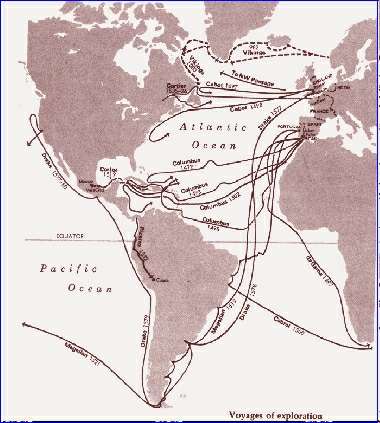|
PinkMonkey Study Guide - American History
1. 1 The Discovery of America
Europe at the time of Columbus
At the time of Columbus’ discovery of America,
Europe was in a state of war. The Crusades - a series of wars against
Islamic territory along the eastern Mediterranean, especially the
Christian Holy Land - brought about trade contacts with the East.
In the thirteenth century, the rise of the fierce
Mongols in the East served to help the European economy. When the
Mongols were in power, trade from the East came to the European
continent through the Byzantine Empire and then by sea to Venice
and Genoa. The city-states of Venice and Genoa had become the chief
trading centers for the import of spices and other commodities from
the Far East.
Trade contracts with the Moslems and later with
China led to the spread of scientific and technological know-how
from the Muslims. Their (the Muslims’) knowledge of mathematics,
astronomy and navigation was far superior to that of the Europeans
then. This knowledge from the Orient helped Europe to use the ’lateen
rigging’ method to make ships sail faster.
The Venetian, Marco Polo, visited and spent 20
years in the Far East. His written records on his journey in the
East gave Europeans first-hand information about the geography and
civilization of the Orient. It also gave them valuable information
about the technological advances made by China then, especially
the invention of the gunpowder. These inventions and scientific
knowledge were borrowed from the east and were improved upon in
Italy. This put Europe on the path of technological revolution and
superiority.
The beginning of the fourteenth century saw the
rise of the Ottoman Turks. Soon the Ottoman Empire was ruling over
a vast territory from West Africa to Indonesia, including the Indian
Ocean. The rise and expansion of the hostile Ottoman Empire affected
trade in Europe. Spices and commodities could no longer be carried
overland to Constantinople. Now ships had to sail to the Red Sea
or the Persian Gulf. From here, they went to Europe via the Mediterranean
ports in Africa and Asia Minor. The long route coupled with the
tolls that the ships had to pay on the way sent the price of spices
spiraling in Europe.

Voyages of Exploration
Exhibit 1.1
Click Here to Enlarge
The beginning of the fourteenth century saw the
rise of the Ottoman Turks. Soon the Ottoman Empire was ruling over
a vast territory from West Africa to Indonesia, including the Indian
Ocean. The rise and expansion of the hostile Ottoman Empire affected
trade in Europe. Spices and commodities could no longer be carried
overland to Constantinople. Now ships had to sail to the Red Sea
or the Persian Gulf. From here, they went to Europe via the Mediterranean
ports in Africa and Asia Minor.
The long route coupled with the tolls that the
ships had to pay on the way sent the price of spices spiraling in
Europe. Since spices were a necessity, the demand for them grew
rapidly with the growth in population. These factors made Oriental
spices both scarce and expensive. In 1453, when the Turks occupied
Constantinople, the old trade route to the East was totally closed.
Something had to be done to deal with the demand for spices. Was
it possible to reach the Orient through another route?
[Next Page]
|